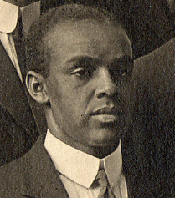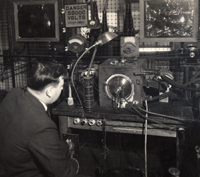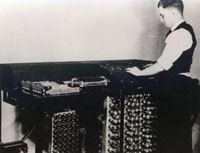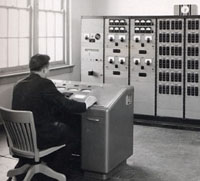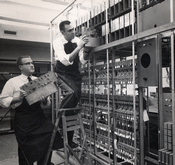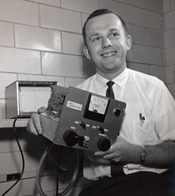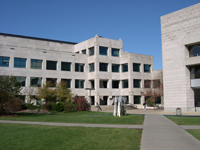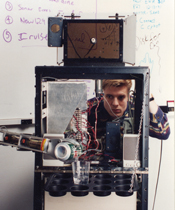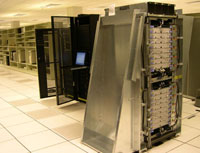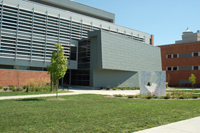1891
Iowa State College establishes the Department of Physics and Electrical Engineering, offering both courses in electrical engineering and physical science.
1909
The Department of Physics and Electrical Engineering splits into two departments and the Department of Electrical Engineering is established.
The department’s first home, the Engineering Annex, opens.
1913
Claron Hutchison is the first African American graduate of the Department of Electrical Engineering.
1914
Paul Spencer Clapp, who earned his electrical engineering degree at Iowa State in 1913, is an engineer on the first transcontinental telephone line. Following World War I, he leads efforts to re-establish telephone and telegraph communications in all of central and southeastern Europe and is knighted by the Romanian government for his work.
1915
The telephone lab is created and first courses in telephony and telephone engineering are offered.
1916
First courses in radio and telegraphy begin.
1921
Department constructs its own radio tower and station; begins broadcasting in 1922.
1922
VEISHEA, the nation’s first and largest student-run festival, is started by combining the festivals celebrated by each division. Electrical Engineering Professor Frank Paine submits the winning name for the new celebration. The letters stand for the first letters of the divisions: V—Veterinary Medicine, E—Engineering, IS—Industrial Science, HE—Home Economics, A—Agriculture.
1925
Edd R. McKee is awarded the department’s first Master of Science degree in electrical engineering.
1927
Ronald J. Rockwell joins Crosley Corporation where he pioneered radio, high-fidelity, and television technologies, as well as designed the first high-resolution TV transmitter in the Midwest.
1932
Oral A. Brown is awarded the department’s first PhD in electrical engineering.
1936
Department receives ABET accreditation.
1937
Alice A. (Churchill) Camerlengo is the first female to receive a bachelor’s degree in electrical engineering.
1939
The world’s first electronic digital computer is built at Iowa State by John Vincent Atanasoff, a physics professor and alumnus, and Clifford Berry, a physics graduate student and electrical engineering undergraduate student. Learn more about the computer, John Vincent Atanasoff (1903-1995), and Clifford Berry (1918-1963).
1947
U.S. Department of Energy establishes Ames Laboratory (now Ames National Laboratory) at Iowa State University.
1949
Warren B. Boast and John D. “Jack” Ryder construct the AC Network Analyzer.
1950
The Electrical Engineering Building opens on campus. In 1969, it was renamed in honor of Mervin Slyvester Coover, who served as department head from 1935 to 1954.
Tetrode neutralization, invented by Alumnus Warren B. Bruene, is used universally in radio transmitters.
1957
Biomedical electronics graduate program is initiated.
1958
Alumnus and Professor William L. Hughes develops a new method of recording and reproducing color TV signals using 35 mm black-and-white film.
1959
The high-speed, digital Cyclone Computer is completed.
The first courses in analog and digital computers are offered.
William G. Anderson is awarded the first Master of Engineering degree in electrical engineering.
1962
Professor Alvin A. Read begins courses on lasers.
1963
The Electric Power Research Center (formerly called the Power Affiliate Research Program) is created.
1964
Professor David L. Carlson creates infant respiratory augmentor.
1967
Anson Marston Distinguished Professor R. Grover Brown begins early GPS research.
1971
David C. Nicholas, electrical engineering graduate student, invents an encoding process that helps make fax machines a staple in office equipment.
1972
Thomas M. Whitney, alumnus, develops first handheld scientific calculator.
1973
Alumnus Donald Linder’s Motorola team develops the world’s first portable phone.
1976
Computer engineering undergraduate major is created.
1977
Glynis A. (Fluhr) Hinschberger is the first female to receive a Master of Science degree in electrical engineering.
1978
The department awards the first bachelor’s degrees in computer engineering to Stephen C. Beilby, Stanley D. Smith, Glenn M. Stark, and Michael A. Warner.
1979
Computer engineering program receives ABET accreditation.
Karen L. (Meinert) Murillo is the first female to receive a bachelor’s degree in computer engineering.
1980
Alumnus David R. Ditzel coauthors the famous paper “The Case for the Reduced Instruction Set Computer.” Ditzel was co-originator of the RISC concept. Later, he also was a designer of high-performance SPARC-based computers for Sun Microsystems.
1981
Elham B. Makram is the first female to receive a PhD in electrical engineering.
1982
Howard Shanks establishes Microelectronics Research Center.
1983
James W. Nilsson writes Electric Circuits, one of the nation’s bestselling electric circuits textbooks.
1984
The Department of Electrical Engineering changes its name to the Department of Electrical and Computer Engineering (ECpE).
Alumnus Edward R. McCracken begins working for Silicon Graphics and helps company develop 3-D graphics machines that launched the “world of virtual reality”.
Distinguished Professor Arthur V. Pohm co-invents Magnetoresistive Random Access Memory (MRAM), a revolutionary computer memory technology.
1985
The Center for Nondestructive Evaluation is formed as a National Science Foundation Industry/University Cooperative Research Center.
Computer engineering master’s and PhD programs begin.
Alumnus Bob O. Evans receives the National Medal of Technology for conceiving the first compatible family of commercial computers at IBM in the 1960s.
Jonathan S. Eckrich, Syed M. Sarwar, and Hah Young Yoo are awarded the first Master of Science degrees in computer engineering.
Vineet Kumar and Mehrdad R. Mehrdad are awarded the first PhD degrees in computer engineering.
Roza Eskandari is the first female to receive a Master of Science degree in computer engineering.
1988
Analog and Mixed-Signal VLSI Design Center is created.
Kevin L. McGahee is awarded the first Master of Engineering degree in computer engineering.
1989
The Charles W. Durham and Marge Henningson Durham Center for Computation and Communication opens. The Durhams are 1939 graduates of Iowa State whose $3 million contribution to expand computer facilities at Iowa State led to the construction of the center. It houses the Computation Center, Telecommunications Office, and ECpE faculty offices and research labs.
Lisa M. (Moklestad) Hining is the first female to receive a Master of Engineering degree in electrical engineering.
Diane (Thiede) Rover, who is now a professor in the department and a former associate dean of the College of Engineering, is the first female to receive a PhD in computer engineering.
1990
Iowa State’s Virtual Reality Applications Center is established.
1991
Aimée R. Willoz is the first female to receive a Master of Engineering degree in computer engineering.
1996
Students build the first Cybot.
Department joins Power Systems Engineering Research Center.
1997
The working replica of the Atanasoff-Berry Computer is unveiled in Washington, D.C.
1998
Alumnus Kenneth M. Peterson is one of three engineers to create Motorola’s IRIDIUM, a worldwide communication system using satellite phones.
1999
Information Assurance Center is founded; Information assurance master’s degree program launches—one of only six in the nation at the time.
2002
A voice-interactive, self-propelled, self-directed, semi-artificially intelligent robot named Octagonal Speech-Controlled, Autonomous Robot (OSCAR) debuts.
Information Infrastructure Institute is created.
2003
University Professor and Alumnus Doug Jacobson creates world’s first Internet-Scale Event and Attack Generation Environment, a virtual cyber security laboratory.
2006
Researchers bring CyBlue, an IBM Blue Gene/L supercomputer to Iowa State. The computer ranked among the world’s 100 most powerful computers at the time it was acquired.
The Department of Electrical and Computer Engineering breaks ground on its multimillion dollar project to renovate and expand its current facilities.
Alumnus Sehat Sutardja is named Inventor of the Year.
2007
The undergraduate software engineering degree program is launched and is administered jointly with the Department of Computer Science.
2008
New Coover Hall building addition, called the ECpE Building Addition, opens.
Alumnus James M. Daughton receives IEEE’s Daniel E. Noble Award for fundamental contributions to the technology that became known as Magnetoresistive Random Access Memory (MRAM), a form of memory that is faster, uses less energy, and is more durable than other memory technologies.
2009
Department celebrates 100 Years.
Cystorm supercomputer, which can perform 28.16 trillion calculations per second, is set up on campus.
2010
Alumnus Gerald J. Posakony wins the American Association of Engineering Societies’ John Fritz Medal—the highest award in the engineering profession for scientific achievement—for his pioneering contributions to the fields of ultrasonics, medical diagnostic ultrasound, and nondestructive evaluation.
U.S. Navy christens new missile range instrumentation ship the USNS Howard O. Lorenzen, which is named after alumnus Howard Otto Lorenzen who was known as the “Father of Electronic Warfare” for his breakthrough work at the Naval Research Laboratory from 1930 to 1973 as a radio engineer and later as the first superintendent of electronic warfare.
2019
The cyber security engineering degree program is launched.
ECpE established a Hall of Fame to forever honor its alumni and faculty for their impactful contributions to the profession and society. Since the department’s inception in 1909, our faculty, staff, students, and alumni have pioneered some of the most renowned modern-era technologies and made this world a better place through their leadership, service, and innovation in research and education. Through this Hall of Fame, the Department of Electrical and Computer Engineering spotlights the impact of these inductees and forever preserves the history of their contributions, letting this stand to inspire future generations of engineering leaders. Thirty-two people were inducted into the inaugural class on Oct. 10, 2019.
